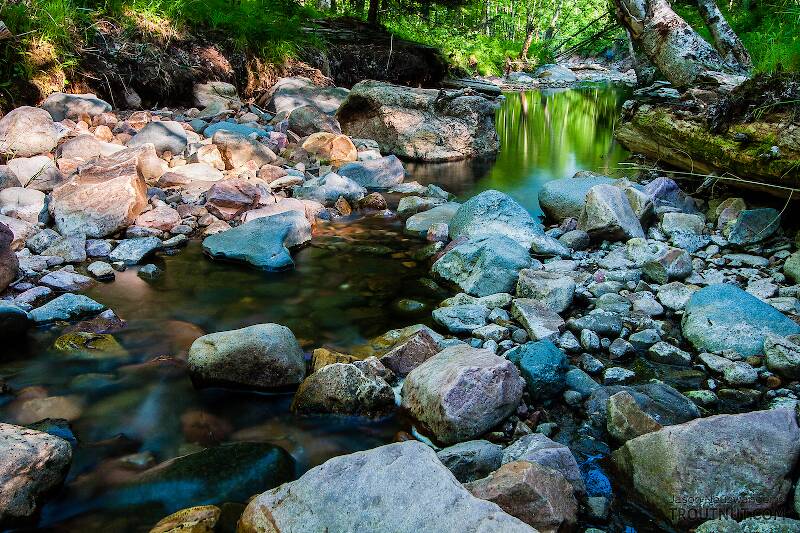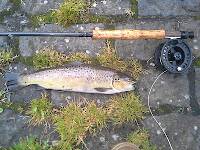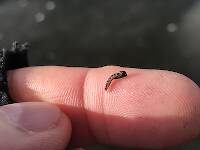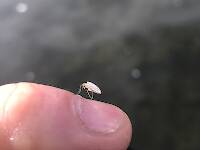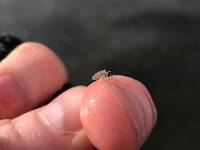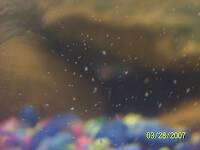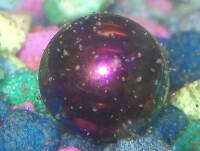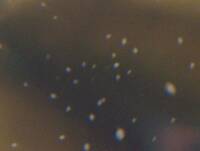
Salmonflies
Pteronarcys californica
The giant Salmonflies of the Western mountains are legendary for their proclivity to elicit consistent dry-fly action and ferocious strikes.
Featured on the forum

Nymphs of this species were fairly common in late-winter kick net samples from the upper Yakima River. Although I could not find a key to species of Zapada nymphs, a revision of the Nemouridae family by Baumann (1975) includes the following helpful sentence: "2 cervical gills on each side of midline, 1 arising inside and 1 outside of lateral cervical sclerites, usually single and elongate, sometimes constricted but with 3 or 4 branches arising beyond gill base in Zapada cinctipes." This specimen clearly has the branches and is within the range of that species.

Troutnut is a project started in 2003 by salmonid ecologist Jason "Troutnut" Neuswanger to help anglers and
fly tyers unabashedly embrace the entomological side of the sport. Learn more about Troutnut or
support the project for an enhanced experience here.
Jimalxndr on Dec 10, 2014December 10th, 2014, 12:56 pm EST
Hello everyone, first time poster.
I have done quite a bit of reading and talking to other anglers, but I am struggling to put together a good method forchoosing what flies to use if I can't find any insects under the rocks. BTW, im fishing for trout. ome say in north carolina winters, I should use something with a bright hot spot in clear water becquse the fish are lethargic, while others say I should avoid them under the same circumstances because loud colors in clear water will spook the fish, and save them for a cloudy water.
It's dwrn near impossible to remember all the things I've read as to which flies to use under specific circumstances, so im looking for some basic guidelines that can demystify fly selection :)
I imagine there are different eays to look at this and there is probably no one formula for success, but I would love to hear from some of the experienced what works for them.
Thanks to all for their help and suggestions,
Jim
I have done quite a bit of reading and talking to other anglers, but I am struggling to put together a good method forchoosing what flies to use if I can't find any insects under the rocks. BTW, im fishing for trout. ome say in north carolina winters, I should use something with a bright hot spot in clear water becquse the fish are lethargic, while others say I should avoid them under the same circumstances because loud colors in clear water will spook the fish, and save them for a cloudy water.
It's dwrn near impossible to remember all the things I've read as to which flies to use under specific circumstances, so im looking for some basic guidelines that can demystify fly selection :)
I imagine there are different eays to look at this and there is probably no one formula for success, but I would love to hear from some of the experienced what works for them.
Thanks to all for their help and suggestions,
Jim
Martinlf on Dec 10, 2014December 10th, 2014, 2:14 pm EST
Welcome, Jim, I spent many happy years in Chapel Hill. Yes, it is confusing to sort everything out you hear when you're first beginning. And sometimes when you've been at it a while. The first thing you might try is asking at a fly shop where the folks know the stream. They should be able to suggest a few basic flies to start out with any time of year. If that is not feasible, perhaps this will help: most trout streams have mayflies, midges, and caddis in them, and although I have boxes and boxes of flies, I often start off nymphing with a simple bead head hare's ear. If you tie, you don't need any tails, ribbing, etc. In the right size (generally bigger for higher, faster, or more cloudy water, smaller for lower, slower, or clear water) this fly, with a dead drift, will often catch fish. I tie most of mine with a small fluorescent orange hot spot just behind a gold bead in all sizes, and typically fish that fly, but sometimes I'll use a version with no hot spot if I think the fish may be spooked by it. I've caught plenty of browns in low clear water with the hot spot version of this fly (called a Walt's Worm in Pennsylvania) in a size 18-22. I also like a plain black, silver bead, zebra midge ribbed with silver wire, especially in waters where midge activity is significant. Match size (and color if needed) to the midges you see flitting about. I just started using this fly a season or two ago, and have been surprised by how effective it is. Another good all purpose nymph is the green weenie, or inchworm. Eric Stroup, a guide on the Little Juniata, once told me he's seen fish swim across the stream to eat this fly. Size is often important, though sometimes a big fly will work in lower clear water. Drift is the key. I'm also partial to the Iron Lotus. Google it. I fish in in many sizes, but mostly smaller ones (16-20) and it's deadly when olives are hatching, or as all around attractor mayfly nymph. It can be tied to represent other hatches, too. With dries, I try to match the hatch, or use terrestrials. But perhaps that's something for another post. Bottom line, you can start with a relatively simple fly selection and catch fish in just about any stream, especially in the freestone streams of the Appalachian mountains near your neck of the woods. (Spring creeks sometimes call for other flies, though.) As my friend Westbranch says in another thread, casting and line management skills are critical, often more so than fly selection. Learn these and use these basic flies and you'll be sure to catch fish in many trout streams any time of year.
"He spread them a yard and a half. 'And every one that got away is this big.'"
--Fred Chappell
--Fred Chappell
Jimalxndr on Dec 11, 2014December 11th, 2014, 2:36 pm EST
Thanks for the suggestions, Martin. I like the iron lotus! I'll be taking an afternoon trip on saturday, but I wont have time to tie a lotus for this trip since I lack quite a few of the materials for it.
I've heard winter flies should generally be smaller and darker, does this sound right?
Some other things I'm wondering are should I use bead heads, soft hackles, things like this. Do you have suggestions about these things?
Thanks much,
Jim
I've heard winter flies should generally be smaller and darker, does this sound right?
Some other things I'm wondering are should I use bead heads, soft hackles, things like this. Do you have suggestions about these things?
Thanks much,
Jim
Martinlf on Dec 11, 2014December 11th, 2014, 6:03 pm EST
Jim, almost everything you hear about from fly fishing sources can work, though some things work better than others at times. I"m partial to bead heads fished Euro-style. One if the best fishermen I've seen won't touch them. I've had some very good days with soft hackles, especially during hatches. I don't fish them in the winter, but that doesn't mean some guy might clean up using them on my favorite stream tomorrow. Each fly fisher has to find what he or she likes, what works for him or her, and there's no way to figure this out but by getting what advice you can, making educated guesses, giving it a try, and seeing what you can make work. I use a lot of smaller darker flies in the winter, mainly because I use a lot of zebra midges. But sucker spawn and glo bugs can be very effective depending on the conditions. If the stream has spawning fish and eggs are being eaten, those flies can be the ticket. A few seasons ago a buddy of mine had me meet him up at one of our favorite spring creeks on a cold, snowy day. I used a variety of smaller dark nymphs and he used glo bugs and he caught fish while I didn't. We were back up there a few weeks ago and the situation reversed until he switched over to midge imitations, which had been working for me most of the afternoon. Then he caught the biggest fish of the day. He'll probably read this and smile. A big black wooly bugger can be most effective in the winter under the right conditions, as can other streamers, like the Shenk white minnow. Try to talk to folks who know the streams you are fishing, learn what you can and try what they recommend. Then go out and give it a go. Be ready to try different things; ultimately, nothing substitutes for time on the stream and experimentation. And persistence. More than once I've been about to give up, tried something new, then started hooking up.
About the Lotus. If it looks good to you, don't be afraid to do some substitutions. You don't have to have Coq De Leon for the tails. Any hackle fibers will work, or you can use wood duck, or mallard, or even partridge though they're not as durable as hackle. But be sure to rib with white Uni-thread or, if you have it white Veevus thread. 8/0 or smaller. I coat my abdomens with Sally Hansens (2 coats) and let it dry before tying in the thorax. (Or you can use epoxy, though it's a a bit of trouble; I've also heard of using Zap-a-gap, and it may be the most durable if it doesn't turn white in the water; I've yet to try it. UV cured finishes don't seem durable enough, by the way.) I often use peacock or black ice dub for the thorax; the Arizona dubbing Eagan calls for is a pain to work with, though I like it in low clear water. And use red thread when you dub the thorax, leaving a little collar just behind the bead. Experiment with bead colors; my current favorite is black nickel. Finally, I skip the wingcase, tying the fly basically in the round.
About the Lotus. If it looks good to you, don't be afraid to do some substitutions. You don't have to have Coq De Leon for the tails. Any hackle fibers will work, or you can use wood duck, or mallard, or even partridge though they're not as durable as hackle. But be sure to rib with white Uni-thread or, if you have it white Veevus thread. 8/0 or smaller. I coat my abdomens with Sally Hansens (2 coats) and let it dry before tying in the thorax. (Or you can use epoxy, though it's a a bit of trouble; I've also heard of using Zap-a-gap, and it may be the most durable if it doesn't turn white in the water; I've yet to try it. UV cured finishes don't seem durable enough, by the way.) I often use peacock or black ice dub for the thorax; the Arizona dubbing Eagan calls for is a pain to work with, though I like it in low clear water. And use red thread when you dub the thorax, leaving a little collar just behind the bead. Experiment with bead colors; my current favorite is black nickel. Finally, I skip the wingcase, tying the fly basically in the round.
"He spread them a yard and a half. 'And every one that got away is this big.'"
--Fred Chappell
--Fred Chappell
Quick Reply
Related Discussions
Topic
Replies
Last Reply
1
Sep 14, 2010
by SlateDrake9
by SlateDrake9

